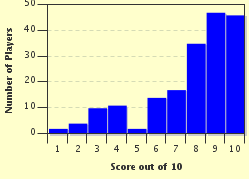Quiz Answer Key and Fun Facts
1. While he was in the middle of his studies on relativity, Albert Limestein had forgotten the well-known equation for mass-energy equivalence that he was famous for discovering. He decided that he would use a fruit-themed mnemonic device to help recall the letters!
By taking the first letter of each fruit to represent the letters in the equation, what did he come up with?
2. This Danish physicist was a part of the Manhattan Project and had an element as well as an atomic model named after him, which Wikipedia says "depicts the atom as a small, positively charged nucleus surrounded by electrons that travel in circular orbits around the nucleus". If his name were fruit-themed, who would it be?
3. Here we have Papayagoras, who is famous for his Papayagorean theorem. Even though the Babylonians had been familiar with this theorem previously, he was the first to create proofs for it. When one learns this theorem, one often learns the concept of a "hypotenuse". Which of the following would have a "hypotenuse"?
4. Marie Ki-wi was Polish-born and soon became a famous physicist and chemist, becoming even more famous than her husband, Peach-erre. She is also particularly famous for the way in which she perished, due to aplastic anemia from an outside cause. Not to be entirely morbid, but what food preparation is the most comparable way for a kiwi to perish?
5. Enrico Pearmi was an Italian physicist famous for his work with quantum theory, particle physics, and statistical mechanics. He even had a particular function named after him which deals with what fruit-related process present in nuclear physics?
6. Here is Johannes Grapeler, a German astronomer who contributed much to the field of optics. He was also an avid defender of a certain model of the heliocentric universe, proposed by what fruit-themed Renaissance astronomer?
7. Henry Gourd was well-known for "Gourdism", an economic model of production in which one mass produces inexpensive goods while paying workers high wages. This was the production model he used to manufacture his two most famous Model automobiles, which were represented by a single letter. The two models can be discovered by taking the first two letters of which fruit?
8. This Russian chemist with a plethora of facial hair was Dmitri Meloneev. As he is most widely known for developing it, if he were to want to eat some fruit (is that cannibalistic?!), he would be most likely to figuratively eat it where?
9. Frenchman Pierre de Kumquat was most influential to the field of mathematics due to his extremely difficult math problem known as Kumquat's Last Theorem. Over a period of 358 years, mathematicians tried to create a successful proof. It wasn't until 1995 that British mathematician Andrew Wiles provided one. What fruity geometric aspect reductively describes his approach?
10. Gregor Mangol was the father of the modern science of genetics, having successfully studied the concept of genetic variance and forming the idea Mangolian inheritance. Now he has decided to breed a fruit and vegetable together! What vegetable would he be most likely to use as it was the vegetable he used in his experiments?
Source: Author
trident
This quiz was reviewed by FunTrivia editor
bloomsby before going online.
Any errors found in FunTrivia content are routinely corrected through our feedback system.

